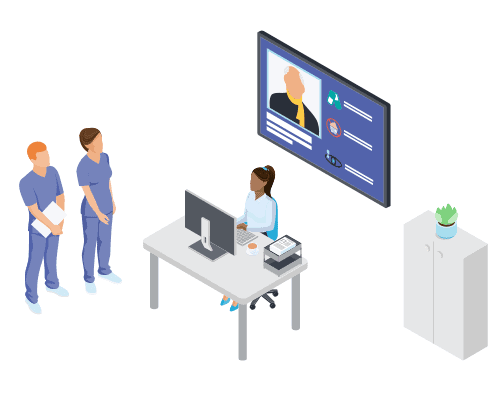
Digital Signage in care homes can bring numerous benefits to both residents and staff, making it a worthwhile investment for care home managers and decision-makers. In this article, we will explore the advantages of Digital Signage and provide detailed explanations about the technology solutions available.
1/ Offer helpful, up-to-the-minute communications
One of the biggest benefits of Digital Signage in care homes is improved communication and engagement with residents and their families. With digital displays, care home managers can easily display important information such as activity schedules, and announcements. This not only keeps residents and families informed, but also helps to build a sense of community within the care home.
Cloud-based content management systems (CMS) enable you to create, edit and schedule content in near-real time to a specific group of screens, or your entire Digital Signage network.
You can also create split-screen content, so guests and residents can see more information, at a glance.
Visitor communications
For visitors in the reception areas and hallways, care homes teams are able to use Digital Signage to display visiting hours, as well as additional helpful information.
With some CMS platforms, for instance, you can access and use, free of charge, on-screen clocks, as well as weather forecast widgets, so visitors can decide whether to spend the visit inside the venue, or in the gardens.
In waiting areas, to keep visitors entertained, care homes also have the option to display infotainment, like news and curated social media feeds from integrated CMS platforms, like Screenfeed and Seenspire.
Additionally, they can feature a full-screen display of a wayfinding map to help visitors navigate their way around the care home.
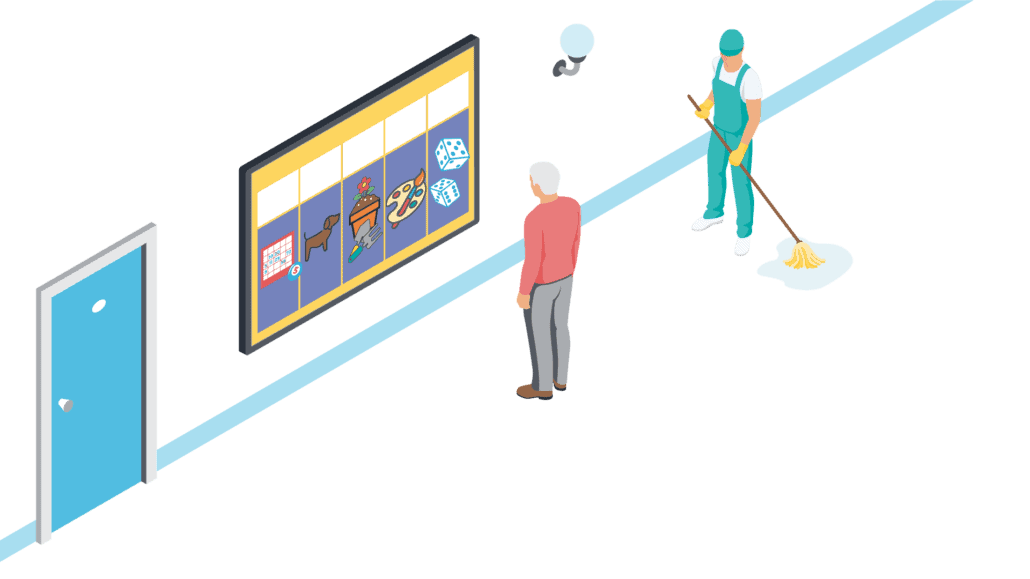
Resident communications
Digital Signage is equally useful when it comes to communicating with residents. To ensure maximum reach and impact, care homes can, for instance, share news of forthcoming social activities, straight to the care home big screens.
With the free calendar integrations provided by some CMS solutions, care homes can share their care home calendars on-screen to highlight special events, and then generate interest for them with dedicated on-screen content sequences.
With integrated CMS HTML tool, Screenfeed Connect, teams can, for example, design content using their own care home pictures, facts and figures, as well as resident feedback, simply by adding them from a file they connect to the platform.
They won’t need any coding or graphic design experience to use this tool. It’s an impactful way for care homes to advertise resident social activities, allowing for the use of pictures from past events, as well as resident recommendations.
2/ Streamline communications workload
With some enterprise-grade CMS platforms, you can access upwards of 500+ content creation tools, which include free widgets like countdown timers. These tools enable you to create a sense of excitement by counting down the time remaining until an event.
Using integrated CMS Menu Board templates, any member of your team can also help to create and advertise menu options on your big screens. Menu Board templates are simple to populate, only requiring you to fill in a Google Sheet. Any time the Sheet is edited, the update will immediately be reflected on-screen on the Menu Board.
With advanced cloud-based CMs solutions, you can also often edit content that’s already been published in near real-time.
Additionally, you also have the option of sharing the workload and securely assigning various levels of content management responsibilities using CMS features, such as Granular User Permissions.
Look out for super-secure CMS solutions from CMS providers, which are IS0-27001-certified – that is, proven to be able to handle and protect large volumes of data.
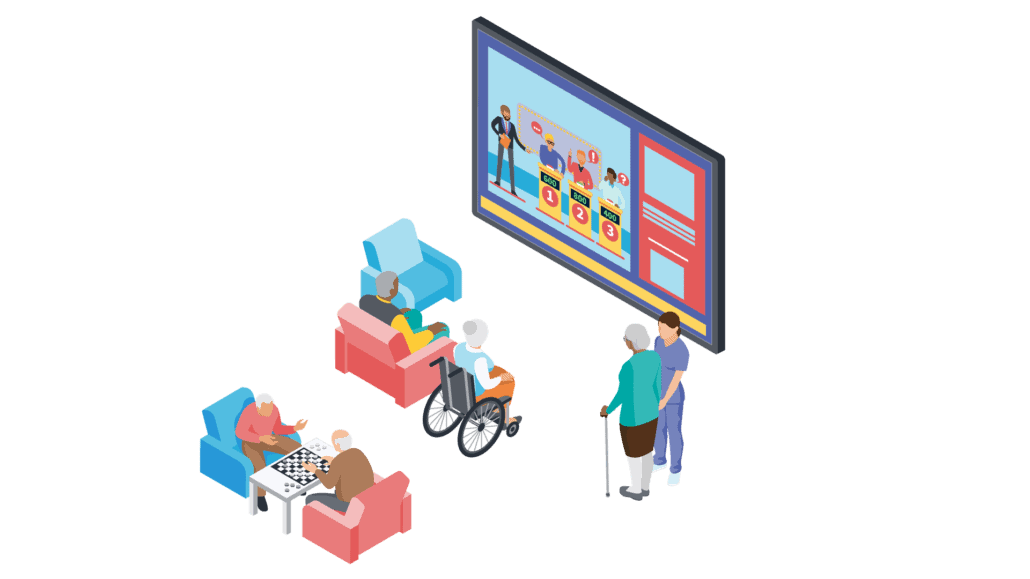
3/ Create inclusive, interactive touchscreen experiences
With interactive touchscreens, you can also help improve the resident experience by, for instance, enabling residents to order menu options directly from the screen.
Interactive touchscreens can even help entertain residents, enabling them to play games and quizzes directly on the displays, as well as video call family and friends.
Additionally, interactive screens are a great way of incorporating resident opinions in the running of your care homes. You can use touchscreens to help collect anonymous customer feedback via on-screen questionnaires and surveys.
CMS solutions that offer a Kiosk Mode ensure some of the most intuitive and responsive touchscreen experiences.
4/ Personalise communications
With cloud-based Digital Signage, you can roll-out a more personalised and targeted communications strategy that will truly resonate with residents. For instance, integrated CMS tools, like Screenfeed Connect make it easy to generate resident-specific messages, enabling you to create celebratory Birthday or achievement posts that feature a picture of the relevant resident.
Additionally, integrated CMS vision AI tools, like MeldCX Viana allow the on-screen content to be changed automatically, according to who is looking at the screen. Using anonymous resident data, this platform enables you to train AI-enabled webcams to detect, for example, residents with mobility aids, and then with the help of your CMS, automatically trigger relevant messages about suitable social activities for them.
Using the metrics of both this platform and your CMS, you can also measure the success of your on-screen content and gain a clearer picture of who is watching it, for how long and when.
5/ Deliver big-screen emergency notifications
With integrated CMS platforms, like Layered Solutions, you can connect your emergency notification technologies, such as fire alarm and security systems, to your Digital Signage. This will ensure that all your big screens will automatically display emergency notifications, warnings and instructions.
In conclusion, Digital Signage in care homes can bring numerous benefits to both residents and staff, including improved communication and engagement, increased operational efficiency, and enhanced safety and security.

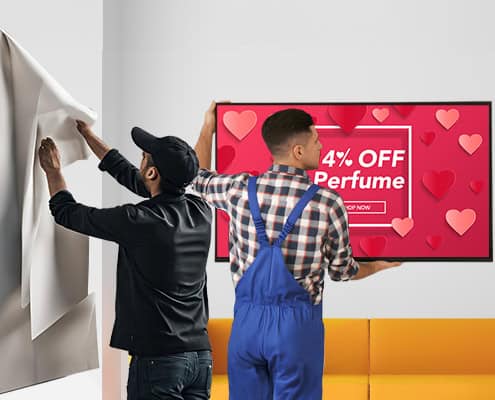
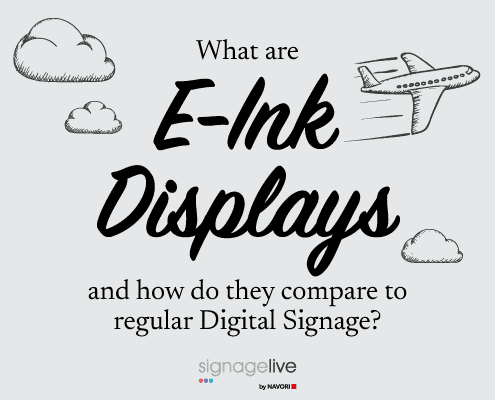

You must be logged in to post a comment.